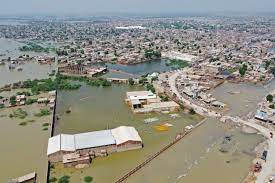The recent floods have affected 33 million people all over the country and almost one-third of the country is still submerged. It is considered the greatest humanitarian crisis in South Asia caused by natural calamity. According to the National Disaster Management Authority (NDMA), the aftermath of floods has severely affected 80 districts out of 160 all over the country, 31 in Balochistan, 23 in Sindh, 17 in Khyber Pakhtunkhwa (KP), 6 in Gilgit Baltistan, and 3 in Punjab. Additionally, 10 million houses have been destroyed, 730,483 livestock deaths have occurred , 1,162 human deaths, 3,554 people injured , 243 bridges collapsed, and 5,063 km of roads are affected by this calamity till the last week of August. The disaster’s financial estimation cannot be accurately taken or perceived at a moment due to submerged land.
In this regard, Sindh is the worst affected province with more than 14 million people being considered ‘badly affected’, according to NDMA, from which 377,000 people are forced to live in camps. Balochistan comes out as the second most affected province where more than 9 million people had to leave their houses and 7,000 are being rovided accommodation in camps. Gilgit Baltistan has declared for the first time ‘calamity-hit’ districts.
Extreme weather conditions place the country in a hazardous zone with unpredictable weather patterns. A decades-long rainfall record has been broken in Sindh and Balochistan in July and August receiving 500 percent more precipitation than the annual average causing excessive torrential rain with the glacial melt in the north of the country.
This year, Pakistan has received more than 190 percent more rain than normal. Due to this, the country has faced flash flooding, glacial lake bursts, and cloud bursts with massive economical and physical loss. However, in the current year, Pakistan is placed as the 8th most vulnerable country on the disaster list due to climate change, by the Global Climate Risk Index 2022. On the other side, Pakistan is in economic and political turmoil and facing additionally, the natural calamity. Inflation is already at the record highest of 27.26 percent, breaking the records of the last 49 years. After getting the bail-out package of $1.17 billion from the International Monetary Fund (IMF), Pakistan has great challenges to overcome the losses caused by floods within its limited resources. It Seems that Pakistan is expecting a difficult winter ahead, especially inthe northern areas, Balochistan and Gilgit Baltistan. The weather conditions in these areas are harsh, and during winters temperatures can drop to around freezing.
According to NDMA’s preliminary information, the major damage occurred to water, sanitation and hygiene infrastructure. Regarding this, 30 percent of the damage was observed in Balochistan, 20 percent in KP and up to 50 percent in the hardest-hit areas of Punjab and Sindh. Pakistan is in a crisis by requiring more financial assistance now in rebuilding efforts, securing gas imports, meeting the demands of IMF, and managing the inflation, on which people are already facing a financial burden.
Regarding the loss of crops, it is estimated that at least 3.6 million acres of crops across the country are affected by floods which include 438,000 acres in Punjab, over 35,500 acres in KP, 304,000 acres in Balochistan, and 2.85 million acres in Sindh. Already the Ukra ine-Russia war has affected the export of wheat and other edibles to its major exporters in South Asian countries.
The basic food necessity is hard to be afforded at lower income levels. In this regard, the petrol price has already been raised to Rs. 2.07 per litre reaching Rs. 235.98 per litre. Meanwhile, Kerosene Oil by Rs.10.92 per litre ( to Rs.210.32 per litre), and Light Diesel Oil by Rs. 9.79 per litre making the increased rate of Rs. 210.54 per litre. With such a higher price, a common citizen is finding it difficult to afford his daily mobility. On the other side, unexpected higher fuel charges have been adjusted in the monthly electricity bill for August. Thus, people have been observed on different platforms raising their voices against inflation, and looking for cushioning, where the country is having a poverty ratio of 39.2 percent in 2022.
By looking at the present scenario of rains, Pakistan has so far faced eight monsoon cycles this year, which normally goes to four. According to the Pakistan Meteorological Department, Pakistan has received the maximum rains this year and it is considered the wettest year. It is being forecast that the rain will go on till October, creating an unusual and difficult situation for a country which is struggling from its economical and political upheavals. The heavy rainfall has caused the Indus River to flow hard. The most affected provinces, Sindh and Balochistan have received rainfall 500 percent above average till August, according to the NDMA. Regarding the loss of crops, it is estimated that at least 3.6 million acres of crops across the country are affected by floods which include 438,000 acres in Punjab, over 35,500 acres in KP, 304,000 acres in Balochistan, and 2.85 million acres in Sindh. Already the Ukraine-Russia war has affected the export of wheat and other edibles to its major exporters in South Asian countries.
The future of importing wheat in this regard also seems to suffer more. In this situation, we have witnessed outstanding support from the country fellows, different organizations, political parties, armed forces, and foreign countries in providing for and facilitating the affectees wholeheartedly. One agenda with the aim can be seen in this regard and wishing for the same on political grounds.
There is a need to think and work on this issue for the future. Pakistan requires more dams for the collection of water instead of getting it wasted. The consumption of water has increased, so there is a need to save water for future use. The loss can be reduced by strict measures such as not granting permission for construction on river banks and river shoulders. However, standing water also gives breeding sites for mosquitoes that cause malaria and dengue fever. Apart from the aftermath of floods, the outstanding approach on one agenda is being observed that is highly appreciable as with limited resources, the government cannot work alone. May Allah take out Pakistan from the emerging crisis and keep the solidarity among all on all issues. Especially, in politics, by looking at the unpredictable election results and differences in ideologies resulting in aggressive clashes on the ground.























